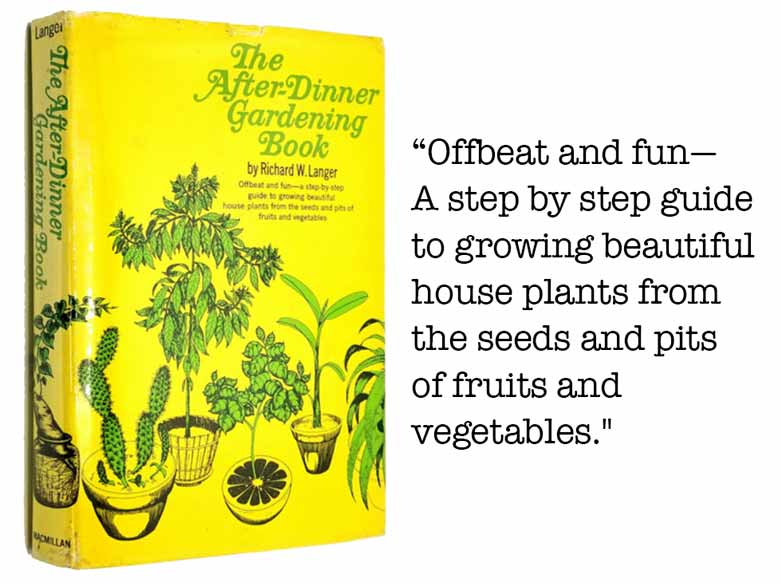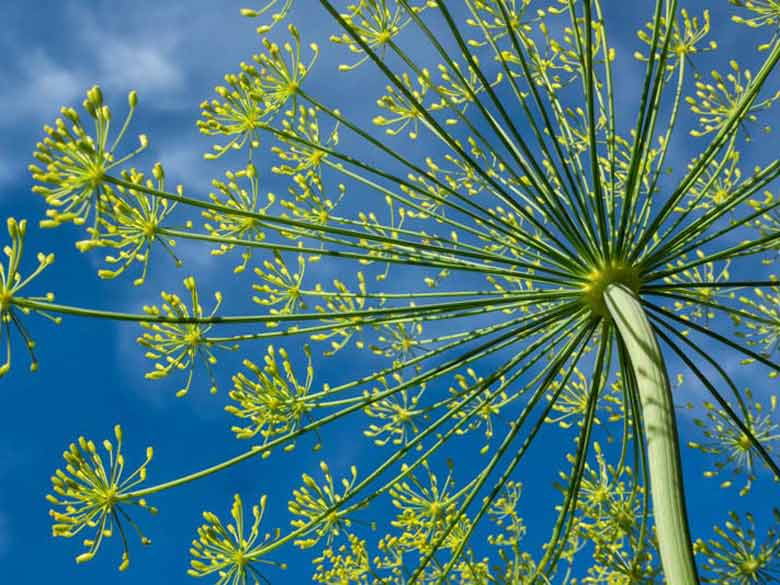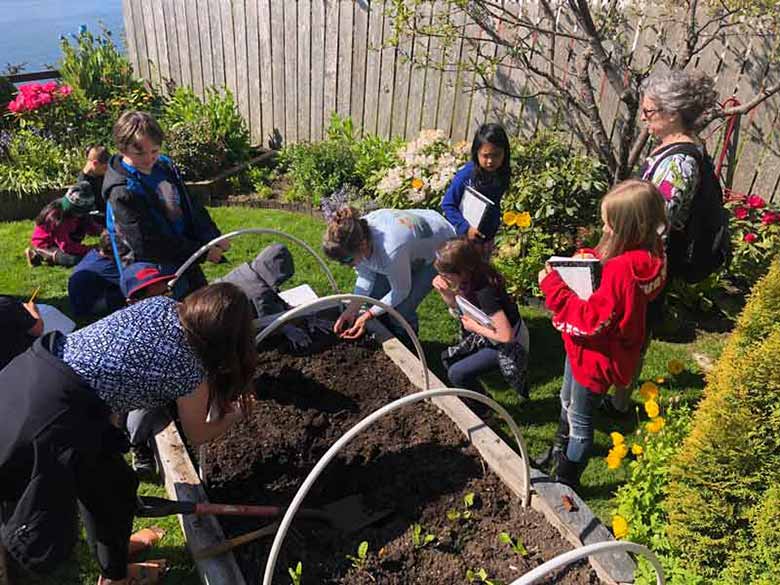I went to a garage sale recently in search of a used shovel. No luck. But I did find a used book of hysterical gardening stories. (More on that in a second). Okay, I know you’re here for gardening tips. Like easy vegetables to grow in short seasons. And you shall have them because, in this article, you’ll find some cool stuff:
- Three comprehensive lists of easy vegetables, herbs, and flowers to grow in cool climate gardens.
- Eight good reasons to start your own seedlings, based on my 30+ years as a garden columnist and teaching gardening workshops.
- A few slightly impressive facts about seeds.
- My favorite (short ‘n sweet) video about how to build stunning flower arrangements.
So let’s not forget the book I found at the garage sale…
It’s called The After-Dinner Gardening Book, by Richard Langer. If you enjoy laugh-out-loud stories, you’ll love this collection. I promise that you don’t need to have a green thumb to appreciate the humor.

In my favorite story, But I Want to Take a Bath, Langer tries to grow a coconut palm. Indoors. From a local fruit stand, he brings home seven of the biggest brown coconuts to be found. Then he fills the bathtub with water and tossed in handfuls of salt. Coconuts, he figures, don’t germinate unless permeated with saltwater.
He plops the coconuts into the tub and withdraws into the living room.
Soon, his wife comes home. Feeling tired, she decides to take a shower.
Five minutes later, Richard looks up to see his wife confronting him. He smiles innocently.
“The bathtub seems to be full of coconuts,” she says. “They going to be there long?”
“About two months,” he says. “Why?”
“Oh nothing, I just thought I might want to take a bath—before next year.”
Oh, dear.
Every story in The After-Dinner Gardening Book is Entertaining, Educational, and Enlightening — The Three “E’s” which, according to Tom Hanks, provide the best foundation for stories, movie plots, and podcasts.
Every spring, I think about Langer’s humor as I set about planting seeds — one of my favorite things to do, especially as I emerge from a winter in Kodiak, Alaska. When I tear open a seed packet and tap seeds into my hand, I’m humbled by the variety of shapes and sizes.
I love seeds!
So what are the smallest seeds? Begonia seeds. The size of dust bits. Ah-choo!
The largest seeds? Coconuts. Yay!
How important ARE seeds? Seeds provide more food for the human race than any other plant or animal. We consume peanuts, chia, quinoa, rice, pumpkin, rye, corn, wheat, oats, pecans, lentils, beans, barley…
[perfectpullquote align=”full” bordertop=”false” cite=”” link=”” color=”” class=”” size=””]Only God can count all the apples in one seed. —Robert H Schuller.[/perfectpullquote]
And now, as promised:
My master list of easy things to grow:
Whether you’re new at cool-climate gardening or you need a creative kick in the plants, er, pants, these lists are meant to inspire:
1. Easy vegetables to grow
- Kale—No veggie garden, smoothie, or life, should be without it.
- Carrots—Sow direct outside; small varieties for tough soils.
- Snap peas—Ideal for small gardens and containers.
- Lettuce—All varieties, but leaf varieties are hardier.
- Potatoes—Short on space? Grow in containers.
- Onion (green and bulb)—Grow from seeds or sets.
- Cabbage—All varieties; space hogs, though.
- Spinach—Will bolt. Sow a new crop every 2 weeks.
- Broccoli—Most all varieties love cool climates.
- Mustard greens and cress—Nutritional must-haves.
- Asiab greens—Chinese cabbage, bok choy, mizuna, all of ’em.
- Broad (fava) beans—The northern lima bean. YES!
- Beets—All varieties. Remember, roots and tops are edible
- Radish—Raw or cooked; rediscover the radish.
- Brussels sprouts—Best eaten after a frost.
- Leeks—Also sweetened by frost.
- Rhubarb—You know, the vegetable that’s really a fruit.
- Turnips—My fave is Hakurei (sweet, white, golf-ball-sized from Johnny’s Selected Seeds)
- Swiss chard—Adds color and texture to your garden and meals.
- NOTE: For greenhouses and hoophouses—Summer squash, cucumbers, pumpkins, tomatoes, peppers, bush beans and pole beans, such as Copra.
If there’s a veggie that belongs on the list, please tell me in a comment below.

2. Easy herbs to grow
- Chives—Divide plants every 3 to 4 years.
- Mint—Keep contained or you’ll have it everywhere.
- Lemon balm—Member of the mint family. Use in baths, iced tea.
- Arugula (garden rocket)–Adds gourmet zest to salads.
- Oregano—Hardy, pretty plant. Dries well.
- Parsley—Another must-have, vitamin-rich.
- Sage—Fragrant perennial; prefers well-draining soil.
- Thyme—Replace plants after several years.
- Dill—Grow for greens, seeds, or both.
- Fennel—A hint of licorice; cook like onions or celery.
- Garlic—Plant cloves in fall for harvest next summer.
3. Easy flowers to grow
- Annuals—Calendula, pansy, nasturtium, sweet peas, baby blue eyes, dianthus, Lunaria, Sweet Alyssum, Iceland poppy, silene.
- Biennials—Foxglove, Sweet William.
- Perennials—Columbine, Shasta daisy, delphinium, bee balm (monarda), Jacob’s ladder, bleeding heart, autumn joy, geranium, forget-me-not, primrose, meconopsis (Tibetan) poppy, Oriental poppy
- Bulbs and other early perennials—Tulips, primrose, daffodils, crocus, snowdrops, lily
Did I miss any flowers? Please leave a comment below.
Speaking of flowers, I’ve posted the flower arranging video at the end of this article.
And now…
8 darn good reasons to start your own seedlings…

1. Connect with Mom
Starting your own plants from seeds is one of the most rewarding and satisfying things you can do. Co-creating with nature is exciting stuff.
(You might enjoy my article about Mother Nature, called Who is Mother Nature? Let’s ask Dr. Seuss, Beethoven, and Julia Roberts).
For one thing, when you get the itch to garden (especially if it’s still winter, right?), starting seeds indoors helps you scratch the itch.
2. Get ahead of the game
When you start your own seedlings indoors, you’re granted a head start on the growing season. We’re talking about a 2 or 3-month boost. That’s BIG, especially if you are a commercial grower. And if you garden in covered beds, a greenhouse or a high tunnel (aka, hoophouse) you gain even more.
3. You want to save money, right?
Have you noticed how much a head of romaine lettuce costs lately? (Okay, maybe that’s not a good example since grocers yank romaine off the shelves occasionally for possible E.coli contamination). Here’s the bottom line: A single head of lettuce costs about the same as a packet of seeds. Easy math.4. More choices, more fun
The first time you dive into a seed catalog, online or in print, you’ll be dazzled and amazed by the varieties awaiting you. After decades of growing my own starts, the selection of produce stocked by grocery stores is downright boring.
By the way: If you find that ordering seeds is overwhelming, I developed a system that simplifies the process. Here’s the article: How to Order Seeds the Easy Way.
5. Do you ever get the winter blues?
Everyone does at some point. My advice: Grow something green, be it easy to grow vegetables, parsley, edible sprouts. Anything. I can honestly say that when I’m tending to trays of young seedlings growing under lights in our garage, I feel uplifted. The winter darkness just fades away.
[perfectpullquote align=”full” bordertop=”false” cite=”” link=”” color=”” class=”” size=””]O, wind, if winter comes, can spring be far behind? — Percy Bysshe Shelley[/perfectpullquote]
6. Peace of mind
Gardening in general and seed starting, in particular, provides a spiritual retreat from a noisy, restless world. Peas on earth, I always say.
[perfectpullquote align=”full” bordertop=”false” cite=”” link=”” color=”” class=”” size=””]They tried to bury us. They did not know we were seeds. — Mexican proverb[/perfectpullquote]
7. Are you a control freak?
When you start your own seedlings, you control more than timing. You also control quality. For example, by embracing organic methods, you avoid chemical residues. Enhance your soil with compost. Topdress with organic mulch. Control pests and diseases with natural methods.
8. Do it for the children
Gardening with kids provides an ideal arena for learning. Counting seeds, tending plants, learning responsibility. Spending time outdoors. Fresh air. Sunshine. Teamwork. What better way to learn about a plant’s life cycle than to watch it from the very beginning?
Speaking of gardening with kids, the former First Lady, Michelle O’Bama was a champion for children’s health. You can read about it in my article When Michelle Obama dug up the White House Lawn.

Remember, seeds account for almost 75 percent of the human diet. Seeds are also part of our language: We speak of the seed of an idea or seed money. Indeed, around 1930, a dollar was called a seed, and we still have birdseed and hayseed and…
In 1985, after living in Kodiak, Alaska for a year, I knew I had to grow at least some of my own food. So, I started growing my own seedlings. Never mind that I didn’t know the first thing about it. But that didn’t stop me.
Now every year, I still marvel at the process: When seeds come in contact with moist soil, that’s nothing less than a miracle.
The After-Dinner Gardening Book was first published in 1969. Eons ago, right? It’s the perfect candidate for an Audible book. (Hello, Amazon!). Still, used copies are cheap as dirt so you might be able to find it in your public library.
Meanwhile, plant a seed.
Grow something.
Live big and love big.
Thanks for stopping by. Until next time,
Cheers!

PS More resources for you:
Compost: The answer to everything!
Hey gardeners, it’s possible to make compost in 6 weeks! Start with my 60-second assessment and get a free report.
My YouTube channel: “It’s Never Too Late”
Helping you make the best of gardening, photography, plant-based cooking, life… all seasoned with inspiration, no matter your age.
Kohlrabi is a must in my garden! It likes our cool weather, easy to grow, a joy to eat raw (I’ve never cooked it, so no opinion there).
Helen, do you eat the kohlrabi greens? Some people yes; others no.
I agree with your vegetable and herb lists – I don’t know much about flowers. And thanks for the tip about the book.
But no, rhubarb is not a fruit, at least not the rhubarb stalk is not. Of course, as in all flowering plants, the rhubarb plant produces fruits – the mature ovaries of the plant’s flowers. In the rhubarb’s case, the fruit is an achene. And it produces many achenes, on a fruiting stalk. Whether to call the rhubarb stalk a “vegetable” is, I think, just a personal preference, with no botanical significance.
But if rhubarb is a vegetable, it is the king of vegetables, a noble and loyal producer of the most exquisite flesh. Its unwarranted association with the lowly strawberry (which can’t even keep its fruits off of the ground) is most unfortunate, and should be vigorously and universally opposed. Authors of cookbooks that propose “rhubarb-strawberry” this and “strawberry-rhubarb” that should be shunned, until they reform.
As for the coconut, what we commonly see in the market is what remains of its fruit, a drupe. The fleshy seed is contained within hard outer shell. A remarkably useful fruit.
Hi Debra, thank you for reminding me about the Trollius and iris. And chocolate lilies… which reminds me how blessed we are that so many plants DO grow well in Alaska. I’m reminded of that when I bite into celery, bought from the store in the winter. Grown somewhere that lacks water. Bitter and tough. I look forward to getting to know you better through my newsletter, where I alert you of blog posts, too. I will be sending out a newsletter soon, so if you HAVE signed up, please don’t be overwhelmed with messages! Cheers to you, Marion
Thanks for the great article. I will join your blog list. I taught in Kodiak for a year in 96-97 and when I left a friend made sure I had some starts of Wild Iris and Chocolate Lilies. They are both still growing in my Mat-Valley yard after all these years, and the Iris have been split and shared annually. Maybe you want to add them to your list of easy Perennials. I also have a very cool location but my Trollius and Tulips come back every year as well as most of the others you mentioned. I have to bring my Geraniums inside for the winter.
Hi Debra, we are back in Kodiak after our travels in the Southwest. Oh my, it’s a different world, isn’t it? I love the idea of wild iris and chocolate lilies (I call them “chocs”)on the easy list. I hope your geraniums did OK. Would you like to be on my newsletter list?
Debra, I’m not sure if my question about my newsletter list went through. Would you like to join? It’s a delight.